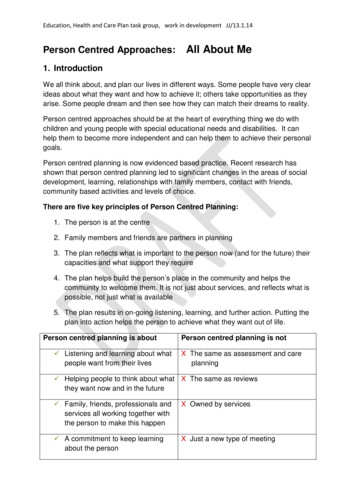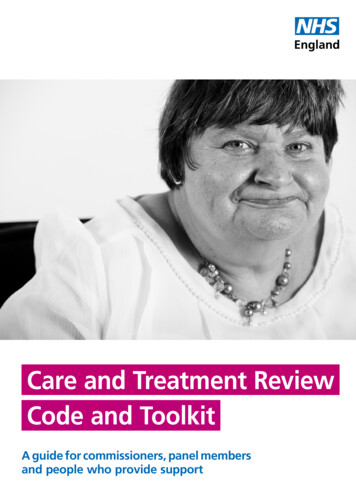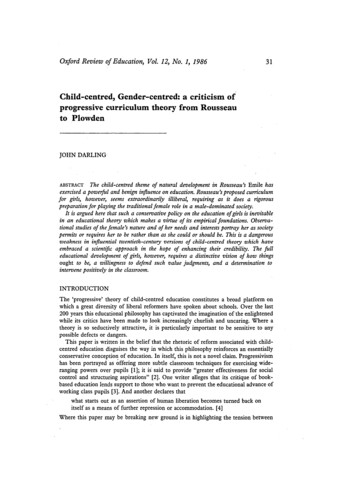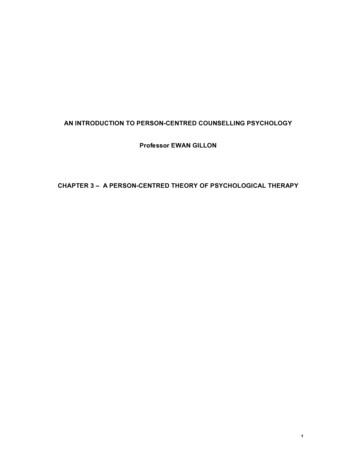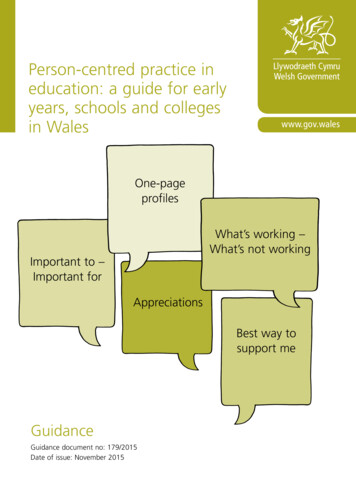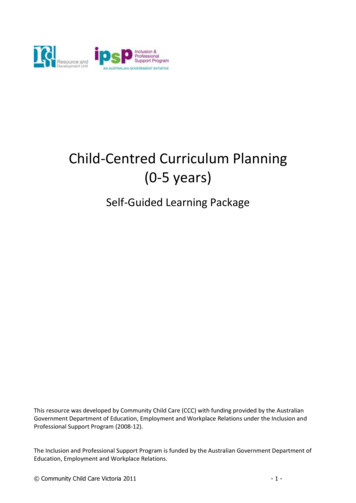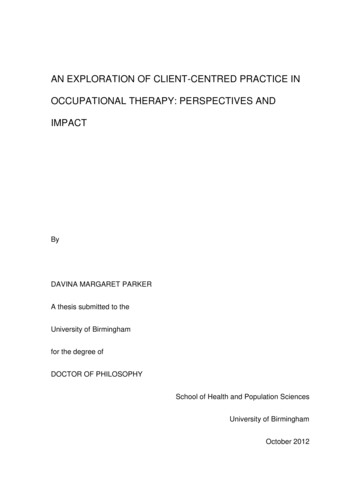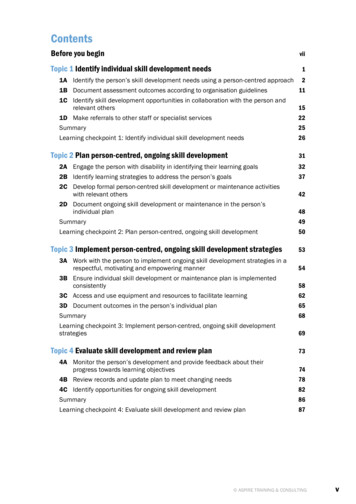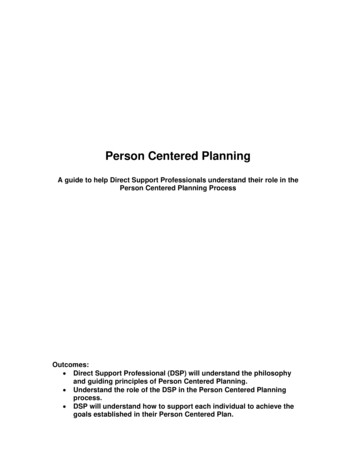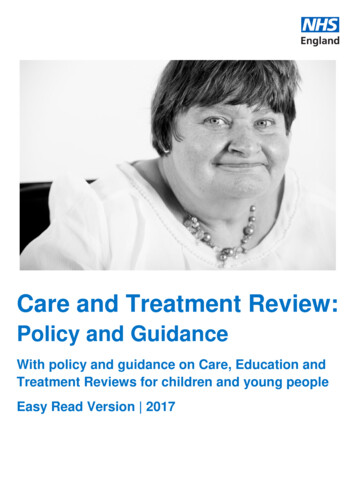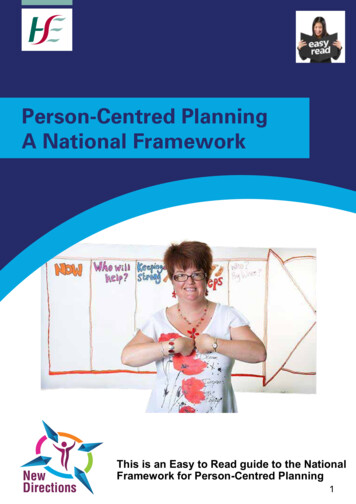
Transcription
Person-Centred PlanningA National FrameworkPerson-CentredPlanningPerson-Centred PlanningANationalFrameworkA National FrameworkThis is an Easy to Read guide to the NationalFramework for Person-Centred PlanningThis is an Easy to Read guide to the National1
Words used in this guideHSEThe HSE stands for the Health ServiceExecutive.The HSE’s job is to run all of the publichealth services in Ireland.HIQAHIQA stands for the Health Information andQuality Authority.HIQA is an independent body.HIQA’s job is to improve health servicesand social care services in Ireland.They inspect residential services for peoplewith disabilities.New DirectionsThe New Directions report was put togetherby the HSE.It is a new way to give day services andsupports to adults with disabilities.21
What isPerson-Centred Planning?Person-centred planning supports you tomake choices about how you want to liveyour life.It is a way to make plans for your future.When person-centred planning works well,you should have a good life.Person-centred planning is about yourhopes and dreams.It is a chance to set goals and say whatsupports you need to reach your goals.32
What is a Framework?A framework is a guide to tell us the bestway to do something.This framework says what we need to doso person-centred planning works well.The HSE and the New Directions PlanningGroup did research on person-centredplanning.People with disabilities, families, circles ofsupport, staff, managers, HIQA and theHSE took part in the research.The research gave us important informationfor the framework.3
Who is the Framework for?People who use disability services, theirfamilies and circles of supportOrganisations that give services to peoplewith a disabilityThe HSEThe Department of HealthHIQA54
What does the Frameworksay about supportingPerson-Centred Planning?65
BeliefsThe framework says that these beliefs are at the centre of goodperson-centred planning.IndividualityEach person is an individual with their ownlife experience, skills, gifts, talents andculture.EqualityEach person with a disability has the samerights as all others in society.Each person is given information andsupport to understand and claim their rights.RespectEach person is treated as an adult.Relationships are built on respect.DignityThe privacy and dignity of each person isrespected.People with disabilities are given thechance to take risks and try new things.76
EmpowermentPerson-centred planning supports theperson to take control of their life.Each person is supported to have their sayand their views are respected.ChoiceEveryone is given the chance to makechoices about their person-centred planand about their lives.Individuals are supported to communicatetheir choices and decisions.Inclusion and active citizenshipEach individual is a valued member of theircommunity.They are trusted to do important jobs intheir community.Person-centred plans support the person totake part in their community, to make newfriends and have new experiences.IndependenceEach person is supported to be asindependent as they can be.87
FoundationsThe framework says these foundations are the building blocks ofperson-centred planning.BeliefsOrganisations work in a person-centredway.They follow the beliefs on pages 6 and 7.Person-centrednessServices and supports are built around theneeds of each person rather than a group.OutcomesPerson-centred planning is about achievingoutcomes for the person.Outcomes are good changes that give eachperson a better life.98
Planning across an organisationPerson-centred planning is part of how thewhole organisation works.It is not a new or separate service.Every plan is differentEvery person-centred plan is a one-off.It shows the individual’s strengths, needs,goals, dreams and wishes.ListeningIndividuals, staff teams and managersreally listen to and support the choices thateach person makes.They listen and respond to the decisions ofthe person and their family.The person decides if they want their familyto be involved.109
ResponsibilityIndividuals, staff teams and managers showhow they support each person to achievetheir personal goals and outcomes.They answer any questions that a personmay have about their supports.ExpectationsThere are high hopes for each person.Person-centred planning encourages eachperson to believe in themselves and to bethe best they can be.RelationshipsIndividuals, staff teams and managersmake sure that each person has the time,space and chance to build goodrelationships.PartnershipIndividuals, staff teams and managers worktogether with people with disabilities.Power is shared and there is goodcommunication.Each person can get the information theyneed to have a say in services andsupports.1110
How can organisations supportperson-centred planning?Make sure each person lives in a nice placewhere they get the chance to do interestingthings, try new things and meet differentpeople.Have good managers who run the servicewell and make sure person-centred plansare of good quality.Make sure everyone in the organisation issupported to communicate well.Make sure staff get the supports they needto do their job well.Make sure people with disabilities and theirfamilies are involved in making decisionsabout the service.1211
Make sure money is managed and spentwell in the organisation.Keep trying to make the services andsupports better and more person-centred.Work hard to make links with thecommunity.Set up circles of support for people withdisabilities.1312
How can I take part inPerson-Centred Planning?1413
The stages ofperson-centred planningThere are four stages of person-centred planning.1. Getting ready to do a person-centred plan2. Putting a person-centred plan together3. Putting a person-centred plan into action4. Finding out if person-centred planning isworking1514
What can I do if I want aperson-centred plan?Find out about person-centred planning andhow it can work for you.Decide if this is a good time for you to havea person-centred plan.If you decide to have a person-centredplan, take part from the very start.Think about your dreams and wishes.Work on your goals and on making goodchanges in your life.1615
The Planning TeamYou may need a planning team to help you put your person-centredplan together and to put it into action.There may be different people on your team:You – the person who owns the planA person to support you to put your personcentred plan togetherA person to support you to put yourperson-centred plan into actionYour family if you wantOther people who support you from time totime.It might be a therapist, psychologist, nurseor social worker.1716
Circle of SupportA circle of support is a group of people thatyou choose to support you.There should be people from yourcommunity in your circle of support.It could be a friend, neighbour, work friend,advocate, volunteer.Your family can be part of your circle if youwant.Staff might sometimes be part of a circle ofsupport, if you want.1817
How to check if person-centredplanning is working for you?Talk to the people supporting you with yourperson-centred plan – staff, your family,your circle of support.Think about any good things or goodchanges that have happened in your life.Think about how your person-centred planguides the way you get services andsupports.There is an easy to read booklet with theframework.This booklet will support you to check howperson-centred planning is working for you.1918
This information was put togetherby the HSE and the NationalDisability Authority.This Easy to Read booklet wasput together by ACECommunication with the help ofExperts by Experience.NDA25 Clyde RoadDublin 42001-6080400www.nda.ie
NOTES21
NOTES22
23
www.hse.ie/newdirectionsModern Printers 056 7721739Contact details:
Person-Centred Planning? 5 Individuality Each person is an individual with their own life experience, skills, gifts, talents and culture. Equality Each person with a disability has the same rights as all others in society. Each person is given information and support to understand and claim
